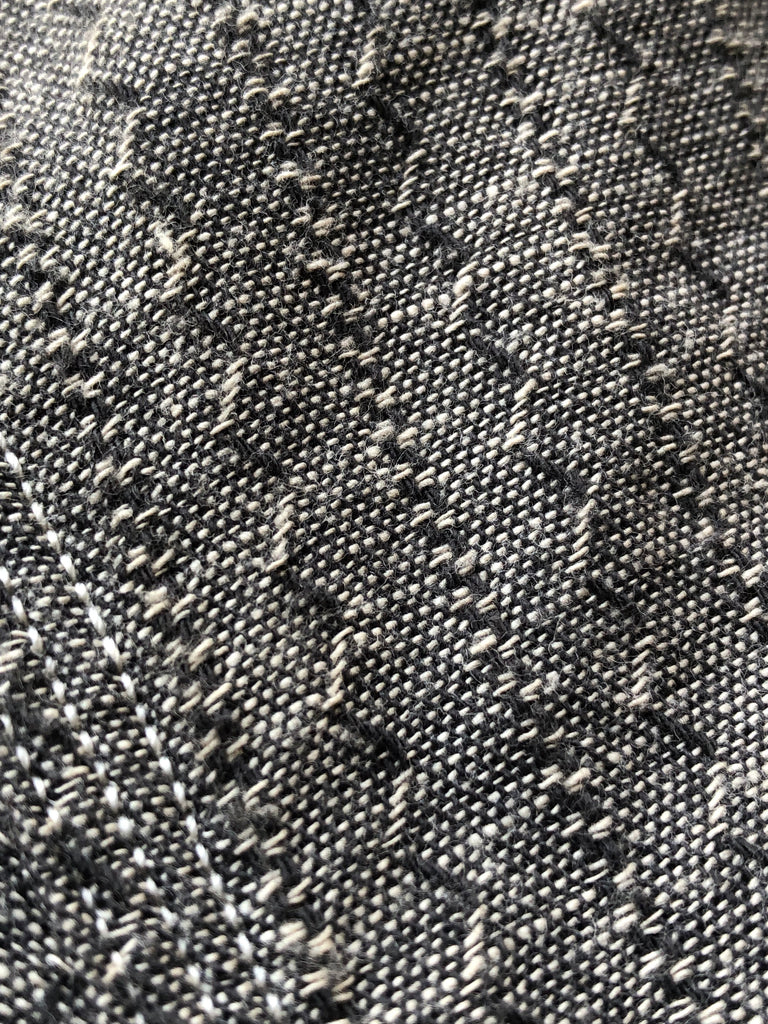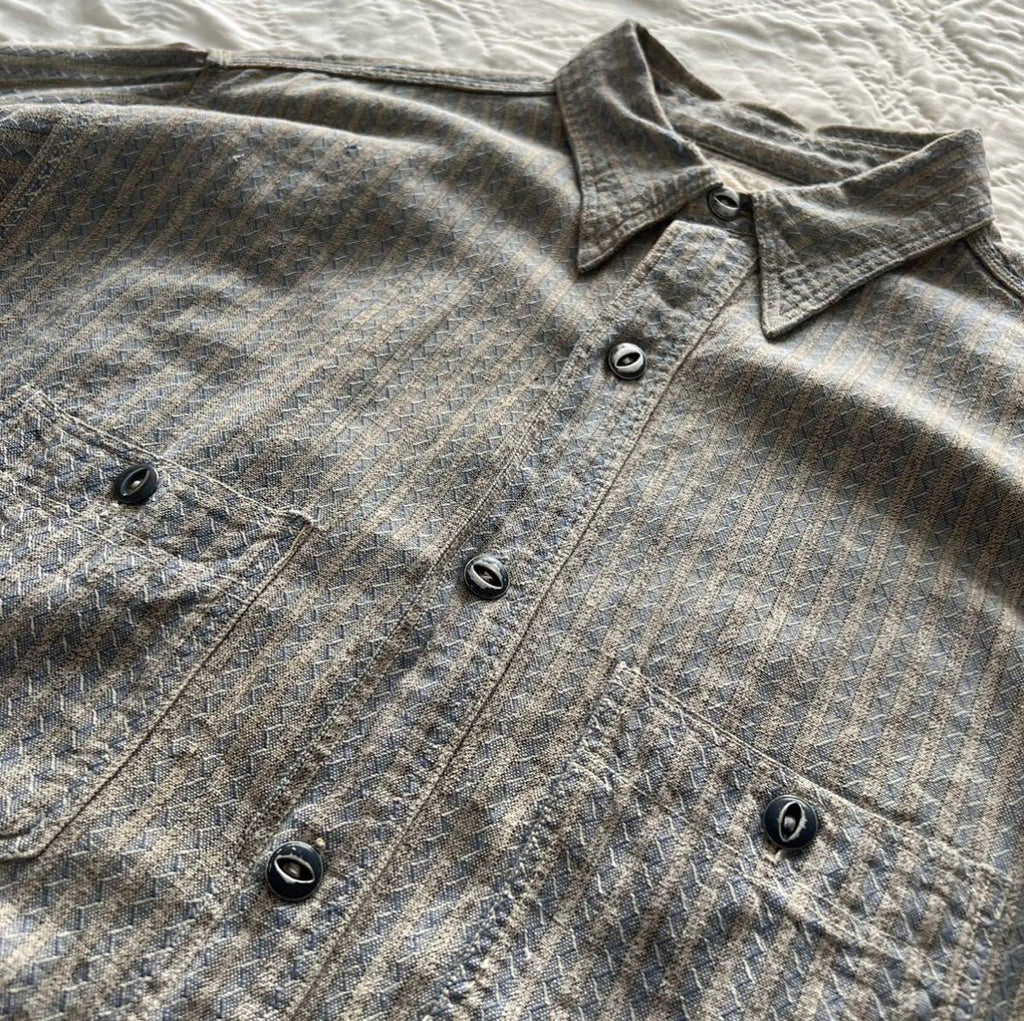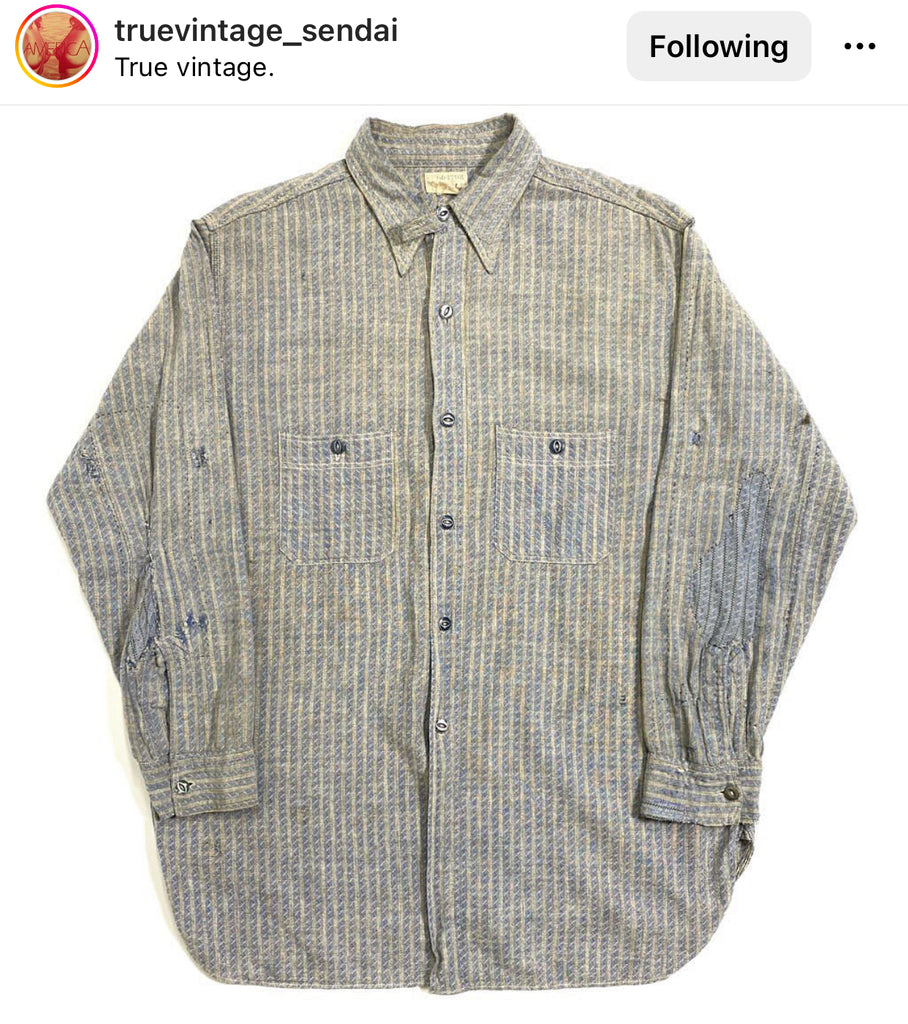
Tupelo, Mississippi: it’s best known as the birthplace of Elvis Presley, but to those interested in the history of American workwear, it’s also likely the home of a special fabric. That textile is Tupelo madras chambray, a much sought after vintage collectible that’s rarely reproduced, and one that might have an Elvis connection, too, as we’ll see.
What is Tupelo madras chambray? It’s a shirting and dress fabric woven with ‘fancy’ patterns, popularly used for work clothing between the late 1920s and late 1930s. Catalogs from Sears Roebuck, Montgomery Ward and more featured Tupelo madras work shirts for men and fabric sold by the yard for the whole family.


Tupelo fabrics by the yard in the Sears Roebuck 1934 Fall catalog.

And in 1932.
Tupelo madras’ various designs are woven, as previously stated, not printed on; the zig-zag pattern was the most common and popular, such as this one found by Justin Steinke of Solid Goods Vintage:






Now why was it called Tupelo madras chambray? The most likely answer is that it was first woven at the Tupelo Cotton Mills in Tupelo, Mississippi. The mill was founded in 1901 and was the town’s first major industry. The name “tupelo” came from the many tupelo trees growing in the area, and the tree’s name in turn was a transliteration of the Creek words “ito”, meaning 'tree' and “opilwa”, or 'swamp'.
The Tupelo area, like much of Mississippi and the South in general, owed much of its economy to “King Cotton” in the 1800s, but business minds knew that cotton prices ebbed and flowed, sometimes crashed, such as during the depression of the 1890s when cotton prices plummeted. Economic diversification became paramount and they were intent on industrializing even when many in the area resisted any attempt to move away from what was still the state’s primary business, agriculture.
Northeastern mills had also begun setting up operations in the South in the late 1800s, looking to take advantage of proximity to cotton fields, warmer weather, lower wages, and weaker unions. Mississippi had joined the fray with four major mills before the Civil War, all four of which were destroyed during the fighting. Yet the business-minded rebounded and mills opened again in the following decades. Tupelo businessmen sought to bring a mill to their town as well.

Postcard image courtesy of the Cooper Collection in the Mississippi Department of Archives and History.
The Tupelo Cotton Mill opened in 1901 and became known for its shirting and denim, pin checks, and madras. It’s highly likely that this is where Tupelo madras chambray shirting originated as well.
In 1921, the Tupelo Garment Co. was founded for the sewing of shirts. By 1923 Tupelo fabric for men’s shirts was already appearing in catalogs, such as this woven one in the 1923 Denver Dry Goods Co. catalog, courtesy of Pink Ployd:

Then, in its 1926 Fall/Winter catalog, Montgomery Ward started offering its Rail Splitter Tupelo shirt:

A 1927 article in the Textile World trade publication of New York reported that Tupelo madras fabric was shown by Hesslein & Co. Inc., a fabric wholesaler, at the Twentieth Annual Convention of I.A.G.M. held in Chicago. Sears carried a Hercules sub-brand Tupelo work shirt for the first time in its spring 1927 catalog:


Here’s a Wards example for 1929:

By the 1930s, the Tupelo garment factory employed dozens of seamstresses making clothing, mostly men’s work shirts. One of those seamstresses was Gladys Love Presley, mother of Elvis Presley. She became pregnant with Elvis and his identical twin brother Jesse Garon, who was born stillborn, while working there in 1935. While pregnant with the twins, she appears in the company’s Fourth of July picnic photo, eighth from the left in the front row, though she’s a bit hard to make out here:

Image courtesy of the Tupelo Elvis Fan Club.

Elvis Presley and his parents, Gladys and Vernon, in 1937 when Elvis was about 2 years old. Note his corduroy overalls. Vernon appears to be wearing a Sears Sturdy Oak work shirt. Colorized image courtesy of Lorenzo Folli.
When Elvis was born, a hat was allegedly passed around the sewing company to take up collection for Gladys to help her family. It’s highly possible that during her time there that she sewed men’s Tupelo madras chambray work shirts like the ones we’ve seen so far. Appropriately, the Tupelo Cotton Mill still stands and is used as an events center, including being the venue for the annual Tupelo Elvis Festival.
Tupelo shirting didn’t just stay in Mississippi, as evidenced by it’s popularity with mail order catalogs and department stores. It shipped nationwide and even to South American markets. In a 1938 case brought against Tupelo Garment Co., it’s noted that 90 percent of men’s work shirts and other garments sewn there were shipped to points outside of the state of Mississippi.
Here’s a piece of Tupelo fabric that was used as a repair on a 1930s shirt:


An example of one of the other Tupelo woven patterns:

And another:



Along with a corresponding listing for this fabric in a 1930s Sears catalog:

Shirts from Sears in the mid-1930s:

A Tupelo shirt in the Sears 1932 Fall catalog:


And more fabrics by the yard:


Fabric sold by the yard could be made into just about anything, such as this dress:

The above fabric was sold by the yard in the Sears 1935 Spring catalog as 'engineer chambray':


Here’s Elmer "Hominy" Thompson at his shack home in Sheridan County, Montana, 1937, wearing a Tupelo madras work shirt with the collar folded under, perhaps to keep a little cooler:


Photos by Russell Lee for the Farm Security Administration, courtesy of the Library of Congress.
Here’s a photo of Ez Nichols celebrating his 13th birthday in 1928 in Encampment, Wyoming, while wearing a Tupelo madras pullover work shirt:

Image courtesy of the Lora Webb Nichols Photography Archive, colorized by Bryan Shettig.
And here are two children, one of whom on the right is wearing a Tupelo madras shirt:
A pair of 1930s girls’ work shirts, courtesy of Pink Ployd:

And two more from the Cat and the Cobra vintage, one of which is a J.C. Penney Ox Hide shirt:


Another pattern, this time on an Uncle Sam pullover work shirt by way of Ghost Town Vintage:

This is a zig-zag pattern but with a different style of stripe on a Go-Pfor chinstrap shirt:



This is the same model of shirt sold by True Vintage Sendai:

Note the more common zig-zag fabric used for repairs:


Here are some examples of this fabric from my personal collection:



And here’s the same pattern being worn by Henry Lundgren, manager of Brondtjen Dairy Farm, Dakota County, Minnesota, in 1939:



By the very late 1930s, Tupelo madras chambray began to disappear from catalogs. In a 1938 legal case brought forth by the Ladies’ Garment Workers Union against the company, it’s detailed that the Tupelo Garment Co. had been receiving far fewer orders for their products, for reasons that are not explained, to the point that the company was not making a profit anymore. Shareholders decided to withdraw their investments.
The result was that Tupelo Garment was to liquidate its assets, sell them for cash, and halt operations at its plants in the Mississippi towns of Tupelo, Booneville, New Albany, Baldwyn, and Fulton.
Without the local sewing factories that specialized in making work shirts, it’s possible that Tupelo Cotton Mills began to make less yardage of men’s work shirting as well. Perhaps this is why this fabric didn’t seem to survive into the 1940s. To wit, neither the spring/summer nor fall/winter Sears catalogs of 1940 listed any Tupelo madras shirts.
Here’s a couple more images of Tupelo listings in Sears catalogs from the late ‘30s, the last it would be seen in this time period. After 1939, Sears never carried the shirts, or fabric, ever again.




I would 100 percent buy all the patterns and colors of I could today by the meter. Woven fabrics patterns are my favorite.